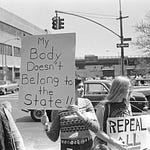In the states…
Texas Lt. Gov. Dan Patrick tried to dance around a reporter’s question about adding in a rape and incest exception to the state’s total abortion ban this week. “I am not saying no, but we’d have to see a real groundswell of Republicans in the House and Senate to say yes,” he said. You can watch the relevant piece of the interview below—and if you’re like me, get mad all over again that this old ass man has any say at all.

A new survey in Wyoming shows that only 7% of the state’s residents support a total abortion ban, with 90% reporting they think abortion should be available at least some of the time. (The state’s trigger ban is currently blocked, and the case has just advanced to the state Supreme Court.) It’s yet another good reminder of how deeply unpopular abortion bans are, and how they’re being pushed against the wishes of voters.
Missouri continues to eye an abortion-rights ballot measure—and Democrats there are working through what it might look like. They could move forward with something like what Michigan did, enshrining abortion rights in the state constitution; or they could return the state to the standards set by Roe v Wade.
The bigger hurdle will be whether Republicans are successful in their efforts to make passing ballot initiatives more cumbersome. Denise Lieberman, director of Missouri Voter Protection Coalition, says, “I think the battle that we’re seeing is that Missourians are working to try and have their voices heard in this way and the legislature is going to try to make it harder for them to exercise the citizen initiative process.”
A legislative work group in Oregon recommended that the state strengthen protections for abortion providers who might be targeted by law enforcement in states that have banned abortion. The report from the Reproductive Health and Access to Care work group recommends codifying a commitment from Gov. Kate Brown not to extradite people who provided health services that are legal in Oregon but illegal elsewhere; prohibiting medical malpractice insurers from denying coverage or implementing rate increases based on a doctor providing abortions; and banning state licensing boards from suspending health care provider licenses for providing abortion care. (The report also noted something I’ve written about here before: that a third of the state’s hospital beds are in Catholic institutions, which further exacerbates the overwhelm among abortion providers.)
Just a reminder that crisis pregnancy centers aren’t just a problem in anti-abortion states. Pennsylvania recently allocated more than seven million dollars to these fake clinics—a fact made even more infuriating by how inaccessible real care still is to a large number of women in the state. Six counties in Pennsylvania qualify as maternal health deserts, and just 17 healthcare facilities in the state provide abortion care. But sure, give some more money to the centers that do absolutely nothing for women.
Quick hits:
Planned Parenthood in Illinois says they’re expecting to see 20,000 to 30,000 more abortion patients a year in the wake of Roe being overturned;
Here’s more information on the protections that New Jersey is putting in place for abortion providers and patients;
And multiple states are considering extending Medicaid coverage for postpartum moms in response to maternal mortality rates, which is great, but won’t mean shit if they don’t do something about abortion rights, as well.
In the nation…
The New York Times points out that collecting data on abortion is going to be harder than ever, now that women will be seeking illegal abortions at a massively increased rate—something made easier by the advent of abortion medication. And while we can do surveys and try our best to get an accurate picture of how many women are self-managing their abortions despite state laws, a truly representative count will be difficult. Dr. Daniel Grossman, director of Advancing New Standards in Reproductive Health, says, “The magnitude, we don’t know that yet. It will take time before we understand the full impact of these bans and restrictions.”
Sen. Tammy Baldwin (D-WI) introduced a bill yesterday that would establish a four-year, $350 million annual government grant program to help women who need to travel out of their home states to get an abortion. The program would allow organizations to apply for federal funding which they could then use to fund the travel, lodging, child care, meals and other costs incurred by those seeking abortion care. It’s unlikely to pass, but this is the kind of pro-active measures I want to see from politicians! Abortion is popular, let’s make sure our legislation reflects that.
Speaking of having laws that demonstrate the reality of abortion rights’ popularity: Leaders in the Democratic Women’s Caucus have written an op-ed calling out fellow legislators for stalling legislation related to women’s rights, saying even the most “bread and butter issues failed to gain enough traction in the Senate.”
“Wake up, Congress—American women are sick and tired of being taken for granted. We’re done holding the proverbial bag. And we’re not going meekly or quietly into the night!”
And at the International Conference on Family Planning in Thailand, reproductive health and justice advocates from around the world expressed concern about how abortion bans in the U.S. will have a ripple effect across the globe. Jedidah Maina, executive director of the Kenyan organization, Trust for Indigenous Culture and Health, said, “When the U.S. sneezes, the rest of the countries catch a cold.”
This is cool: The Brennan Center for Justice and the Center for Reproductive Rights are collaborating to bring us a state litigation tracker for abortion. It’s an incredibly useful tool.
And just a reminder that politicians ignore young voters at their own risk, especially when it comes to abortion rights. Fortune reports that almost half of 18-29 year olds called abortion rights their number one issue when considering their vote, and points to the surge in voter registrations among young people—especially in states where abortion was on the ballot. There has always been this stereotype of young people as politically apathetic or socially unengaged, and I have never ever seen that play out in reality. The best thing we can do as people who care about abortion rights is to continue to reach out to younger people—because they are fighting this fight alongside us.
Quick hits:
USA Today covers the closures of independent abortion clinics across the country;
A poll from GLAAD shows that over 80% of LGBTQ Americans are concerned about the ramping up of anti-trans and anti-abortion legislation;
Actress Kate Walsh talks about the abortion-rights episodes in Grey’s Anatomy;
And The American Prospect interviews longtime Supreme Court reporter Linda Greenhouse on Dobbs.
What conservatives are saying…
Whew! Conservatives are very pissed off about the Associated Press’s update to their style guide on abortion later in pregnancy. Mostly because the more accurate we are about abortion—the language is also recommended by the American College of Obstetricians and Gynecologists—the worse it looks for anti-abortion activists.
This isn’t the first time conservative media has used the AP’s style guide updates to stoke anger around abortion. They lost their shit in May, when the AP said that using ‘pregnant women’ or ‘pregnant people’ would be acceptable; and again in July, they got upset when the AP suggested using ‘anti-abortion’ and ‘abortion rights’ instead of ‘pro-life’ and ‘pro-choice’. Accurate language, it seems, is triggering for them. :)
(By the way, thanks to the Abortion Care Reality Project, who led a months-long campaign explaining why ‘late-term abortion’ was medically inaccurate and harmful.)
Keep an eye on…
This is something I’ve written about a ton but I’m going to keep repeating it: Conservatives are laying the groundwork to blame doctors for the first reported post-Roe death. They’re out there with a messaging campaign that makes it seem as if their laws are perfectly clear and it’s just bad doctors who are misreading the law. (Here’s the latest example if you can stand it.)
You love to see it…
You probably already know Loretta Ross’ work: One of the founders of SisterSong and the activist who coined the term ‘reproductive justice’, Ross is an icon in the abortion-rights movement. The Washington Post has a profile of the MacArthur fellowship winner, where she speaks about what her work and life has been like post-Roe. You should read the whole thing, but I wanted to flag something she said that’s going to stick with me: “The lesson I’m most focused on right now is the importance of maintaining hope.”
Listen to this episode with a 7-day free trial
Subscribe to Abortion, Every Day to listen to this post and get 7 days of free access to the full post archives.














